Right-Sided Heart Failure: Symptoms, Causes, and Treatments - Healthline
Right-Sided Heart Failure: Symptoms, Causes, and Treatments - Healthline |
- Right-Sided Heart Failure: Symptoms, Causes, and Treatments - Healthline
- What Are the 4 Stages of COPD and the Symptoms of Each? - Healthline
- Sildenafil and Cost: Generic, Brand Names, and More - Healthline
- First time in Thailand – Chula Successfully Uses Stem-cell Transplantation to Treat Systemic Sclerosis Patients with Pulmonary Fibrosis - Newswise
| Right-Sided Heart Failure: Symptoms, Causes, and Treatments - Healthline Posted: 04 May 2021 07:38 AM PDT Heart failure is a general term for a weakening of the heart muscle that leaves it unable to pump enough blood to meet the demands of the body. There are actually several types of heart failure, each with its own cause and complications. Right-sided heart failure involves the part of the heart responsible for pumping blood to the lungs, where it receives oxygen. The blood then travels throughout the body to deliver oxygen to your organs, muscles, and other tissues. While treatment options vary, they usually involve a comprehensive approach to maintaining the health of your entire heart and circulatory system. The outlook for someone with right-sided heart failure depends on the severity of the disease, as well as how early treatment begins. While it's sometimes a life threatening condition, it can be managed with a combination of medications, lifestyle changes, and in some cases, surgery. The term heart failure sounds like the heart has stopped pumping, similar to how the phrase "engine failure" means an engine no longer produces any power. Heart failure actually means that the heart muscle has grown weaker and can no longer provide sufficient blood flow to all parts of the body. The heart still pumps, just not as efficiently and effectively as it once did. As a result, the body doesn't get all the oxygenated blood it needs to function and complications affecting various other organs can develop. What is left-sided heart failure?Left-sided heart failure is a more common condition than right-sided heart failure. It happens when the left ventricle has to pump harder than usual to try to deliver enough blood to keep the body healthy. There are two types of left-sided heart failure:
Fluid retention causing swelling in the lower limbs and sometimes the abdomen is a common and obvious symptom of right-sided heart failure, but there are several other symptoms that may develop: When to schedule a medical appointmentIf you notice swelling in your ankles, legs, feet, or abdomen, schedule a doctor's appointment soon or visit a walk-in clinic. Shortness of breath in any situation is also a symptom that demands a medical evaluation. Swelling, fatigue, and shortness of breath are a few hallmarks of right-sided heart failure and you shouldn't ignore them. Call 911 or visit a local emergency medical center if you notice:
 Several factors can weaken the heart and trigger heart failure. Conditions that damage your heart, such as a heart attack, or that make your heart work harder, such as valve disease, can have the same result. Right-sided heart failure can also be brought on by lung disease or pulmonary hypertension. Right-sided heart failure is most commonly brought on by left-sided heart failure. When the left side of your heart weakens, blood can build up within the chambers. This increases the pressure within the blood vessels carrying blood to the lungs — a condition known as pulmonary hypertension. To compensate, the right side of the heart must work harder. Eventually, the right side weakens from the extra effort, and you develop right-sided heart failure. Right-sided heart failure can also be a result of leaky or damaged right-sided valves, such as a leaky tricuspid valve (tricuspid regurgitation). Specific risk factors for right-sided heart failure include:
The proper treatment for right-sided heart failure depends on the underlying condition causing it. Treating right-sided heart failure usually involves the use of one or more medications, lifestyle measures, and possibly implanted devices that support the heart's ability to pump. MedicationsThe following types of medications are among those commonly prescribed to treat right-sided heart failure:
LifestyleTo help your heart work efficiently, the following lifestyle measures are important:
DevicesFor more serious cases of right-sided heart failure, you may need an implanted device to support healthy heart function. A mechanical heart pump can take the form of a ventricular assist device or a total artificial heart, to compensate for the heart's loss of pumping strength. In some cases, surgery may be needed to correct a congenital heart defect that caused the heart failure. Or, in the most serious cases, a heart transplant may be necessary if other treatment options have been unsuccessful. Right-sided heart failure is a lifelong condition, and there is currently no cure. However, many people manage symptoms and maintain a decent quality of life. The key is to work closely with your doctor and follow your medication regimen exactly as prescribed. It's also critical to report any new symptoms and to manage any other medical conditions that could contribute to or worsen because of heart failure. These may include: There are advances in mechanical support devices, suggesting that treatment options will continue to save and extend lives. |
| What Are the 4 Stages of COPD and the Symptoms of Each? - Healthline Posted: 04 May 2021 11:46 AM PDT Chronic obstructive pulmonary disease (COPD) is a group of lung diseases that progress over time. COPD is most common in smokers and people over the age of 40. It's estimated that about 174 million people have COPD, and more than 3 million people around the world die from it each year. People with COPD often have trouble breathing, a persistent cough, and shortness of breath. COPD can be subdivided into stages or grades, depending on how far it has progressed. In its early stages, COPD is barely noticeable, but it gets worse over time unless you get proper treatment. The earlier you catch it, the better your outlook is. Keep reading to learn about the four stages of COPD. We'll break down the symptoms you can expect at each stage and potential treatment options. The Global Initiative for Chronic Obstructive Lung Disease (GOLD) is a program started by the National Heart, Lung, and Blood Institute and World Health Organization. Countries around the world use its guidelines and recommendations for diagnosing and treating COPD. The GOLD system previously classified COPD from stages 1 to 4 solely based on your lung capacity measured by a spirometry test. But the newest GOLD guidelines combine your spirometry results with subjective measures of your symptom severity to determine your level of risk based on their ABCD rubric.  A spirometer test involves exhaling into a machine called a spirometer. The machine measures how hard and quickly you can exhale. Your doctor will examine two numbers: your force vital capacity (FVC) and your force expiratory volume in one second (FEV1). Your FVC is the total amount of air you can breathe out and FEV1 is the amount you breathe out in one second. A ratio of your FEV1/FVC needs to be less than 0.7 for a diagnosis of COPD. Your doctor will grade your spirometry results from grade 1 (least severe) to grade 4 (most severe). These grades correlate with stage 1 to stage 4 COPD in the old system. Your healthcare provider will determine the severity of your symptoms using either the British Medical Research Council (mMRC) questionnaire or the COPD Assessment Test (CAT). Stage 1 COPD is considered mild. At this stage, you may not be aware that you have anything wrong with your lung function. Your doctor will assign you with grade 1 COPD if your FEV1 is between 80 and 100 percent of your predicted value. SymptomsIf you score grade 1 on your spirometry test, you may not have any noticeable symptoms. If you do have symptoms, you may develop a cough and increased mucus production. You may mistake the early stages of COPD for the flu. TreatmentWith stage 1 COPD, your doctor may recommend a bronchodilator medication to open up the airways in your lungs. These medications are usually taken through an inhaler or nebulizer. Your doctor may also recommend getting flu and pneumonia vaccines to prevent illnesses that may worsen your respiratory symptoms. Changing lifestyle habits that led to the development of COPD can potentially help slow the progression of your COPD. Most people with COPD have a history of smoking. Quitting smoking and avoiding secondhand smoke are two of the most important things you can to improve the outlook of your disease. Your COPD is considered to be stage 2 when your FEV1 drops to 50 to 79 percent of your predicted value. SymptomsDuring stage 2, your symptoms worsen from stage 1. Your coughing and mucus production may become more severe, and you may experience shortness of breath when walking or exercising. Typically, it's in this stage that people realize that something is wrong and seek medical attention from a doctor. TreatmentYou may be given bronchodilator medication to increase airflow to your lungs. Your doctor may recommend pulmonary rehabilitation, which is a program designed to increase your awareness about your condition. It's usually offered as a group class where you'll learn how to better manage your condition. If you have a flare-up of symptoms, you may need to take steroids or oxygen. By the time you reach stage 3, COPD is considered severe, and your forced expiratory volume is between 30 to 50 percent of your predicted value. You may have trouble catching your breath doing household chores and may not be able to leave your house. SymptomsBy stage 3, you may get more frequent flare-ups, and your shortness of breath and coughing will get worse. You will likely find you get tired easier than before. Other potential symptoms can include: TreatmentThe treatment options for stage 3 COPD are similar to stage 2. You're more likely to need to go on oxygen at this stage. Stage 4 is considered very severe. Your forced expiratory volume is less than 30 percent of your normal value, and your blood oxygen levels will be low. You're at risk of developing heart or lung failure. SymptomsBy stage 4, you'll likely have frequent flare-ups that can be potentially fatal. You may have trouble breathing even when you're resting. TreatmentTreatment options during stage 4 are similar to the previous stages. Your doctor may also recommend lung surgery to improve breathing. Surgical options include: A grade 4 score on your spirometry test is the highest grade you can receive. This category is also sometimes referred to as end-stage COPD. For many people at this stage, quality of life is usually fairly low, and symptom flare-ups can be fatal. Having COPD lowers your life expectancy. However, the amount that it affects your life expectancy depends on many factors, such as how far your COPD has progressed and whether you quit smoking or change the lifestyle habits that lead to COPD. An older 2009 study found that COPD led to a small reduction in lifespan for people who have never smoked, but a larger lifespan decrease for people who currently smoke or smoked in the past. According to the researchers, a 65-year-old man who smokes would lose 3.5 years from their life expectancy for smoking, plus the following values for having COPD:
For former smokers, the reductions are:
For somebody who never smoked, the reductions are:
In a 2017 study, researchers followed a group of long-term smokers with COPD for 5 years. They found that participants who had died before a 5-year follow-up had a longer average smoking time and a lower prevalence of quitting smoking. The researchers concluded that smoking time may be related to COPD mortality rate, and quitting smoking has the largest potential to influence COPD outlook. COPD can't be reversed, and it's currently not possible to stop the progression of your COPD completely. You can help you slow the progression of COPD as much as possible by working with your doctor and following a proper treatment program. No matter how far along your COPD has progressed, it's important to change the lifestyle habits that caused your COPD in the first place. The most important thing you can do is quit smoking. If you don't quit, you'll continue to damage your lungs, and your COPD will progress quicker than it otherwise would. Eating a low-carb diet filled with plenty of vegetables, healthy fats, protein, and unprocessed foods may help you manage your symptoms and maintain a healthy weight. Eating foods that cause bloating, like apricots or peaches, may exacerbate breathing problems in some people. Regular exercise may help decrease symptoms of COPD by strengthening your respiratory muscles and improving your cardiovascular health. COPD used to be categorized from stage 1 to stage 4 depending on how much your lung function had decreased. Now, doctors combine the results of a lung function test with subjective measures of symptom severity to determine your COPD risk. Quitting smoking is the most important thing you can do after being diagnosed with COPD to improve your life expectancy and outlook. |
| Sildenafil and Cost: Generic, Brand Names, and More - Healthline Posted: 23 Apr 2021 12:00 AM PDT If you're looking at treatment options for erectile dysfunction (ED) or pulmonary arterial hypertension (PAH), you may want to learn more about sildenafil (Revatio, Viagra). Sildenafil is a generic prescription drug that's used to treat ED and PAH in adults. It belongs to a drug class called phosphodiesterase type 5 inhibitors. (A drug class is a group of medications that work in a similar way.) This article gives details about sildenafil and cost, and about how you might save money on your prescriptions. Note: For more details on sildenafil, see this in-depth article. The price you pay for sildenafil can vary. Your cost may depend on your treatment plan, your insurance coverage, and the pharmacy you use. To find out how much you'll pay for sildenafil, talk with your doctor, pharmacist, or insurance provider. Below are answers to some frequently asked questions about sildenafil and cost. Do the different strengths of sildenafil cost the same?No, the different strengths of sildenafil typically vary in cost. Each form of sildenafil comes in different strengths. And both the strength and form of sildenafil you use can affect the drug's cost. The chart below shows the available forms and strengths of sildenafil. * This form is given by a healthcare professional during a hospital stay. Your doctor may prescribe a strength of sildenafil that isn't available from the drug manufacturer. For example, they might prescribe you 60 mg of sildenafil. In this case, you may take three of the 20 mg tablets to form 60 mg. It's important to note that the number of tablets you're prescribed can also affect the price you pay for sildenafil. If you have other questions about how the different strengths of sildenafil vary in cost, talk with your doctor, pharmacist, or insurance provider. How much does Viagra cost compared with sildenafil?Sildenafil is a generic drug. It's also available in a brand-name form called Viagra. Brand-name drugs generally cost more than generic drugs. For more information about the cost of sildenafil compared with Viagra, see the "Is sildenafil available as a brand-name drug?" section below. Sildenafil is available in brand-name versions called Revatio and Viagra. The generic version of sildenafil is sometimes referred to as sildenafil citrate. A generic drug is an exact copy of the active drug in a brand-name medication. The generic is considered to be just as safe and effective as the original drug. Generics also tend to cost less than brand-name drugs. To find out how the costs of Revatio, Viagra, and sildenafil compare, talk with your doctor, pharmacist, or insurance provider. If your doctor has prescribed sildenafil and you're interested in using Revatio or Viagra instead, talk with your doctor. They may have a preference for one version or the other. In addition, you'll need to check with your insurance provider. This is because it may only cover one drug or the other. If you take sildenafil long term, you may be able to lower your costs in the following ways:
If you need help covering the cost of sildenafil or understanding your insurance, check out these websites: On these sites, you can find insurance information, details on drug assistance programs, and links to savings cards and other services. If you have questions about how you can pay for sildenafil, you may also want to talk with your doctor or pharmacist. If you still have questions about the cost of sildenafil, talk with your doctor or pharmacist. They may be able to give you a better idea of what you'll pay for this drug. But if you have health insurance, you'll need to talk with your insurance provider to learn the actual cost you'd pay for sildenafil. Examples of questions you may want to ask your doctor or insurance provider include:
For information on nutrition, fitness, sex, stress relief, and more, sign up for the men's health newsletter from Healthline. Disclaimer: Healthline has made every effort to make certain that all information is factually correct, comprehensive, and up to date. However, this article should not be used as a substitute for the knowledge and expertise of a licensed healthcare professional. You should always consult your doctor or other healthcare professional before taking any medication. The drug information contained herein is subject to change and is not intended to cover all possible uses, directions, precautions, warnings, drug interactions, allergic reactions, or adverse effects. The absence of warnings or other information for a given drug does not indicate that the drug or drug combination is safe, effective, or appropriate for all patients or all specific uses. |
| Posted: 04 May 2021 05:55 AM PDT Newswise — April 8, 2021 – The Division of Rheumatology, Department of Medicine, Faculty of Medicine (CU Medi), Chulalongkorn University and King Chulalongkorn Memorial Hospital, the Thai Red Cross Society (Chulalongkorn Hospital), in collaboration with the Departments of Hematology, Pulmonary and Critical Care Medicine, and Infectious diseases, held a press conference on "Thailand's first successful treatment of systemic sclerosis patients with pulmonary fibrosis by stem cell transplantation". 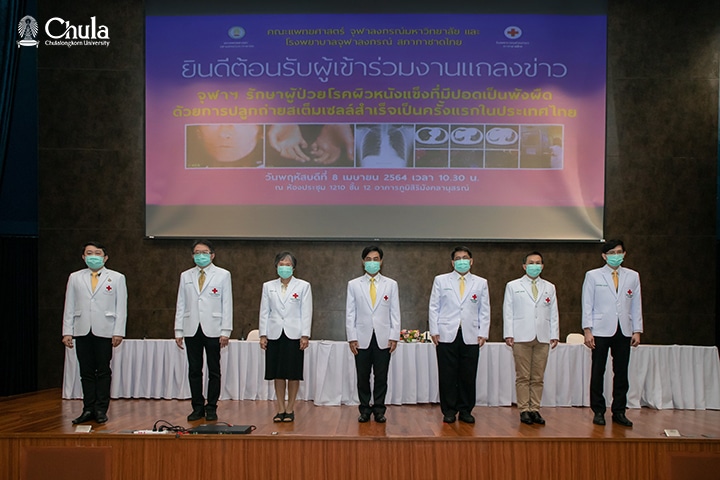 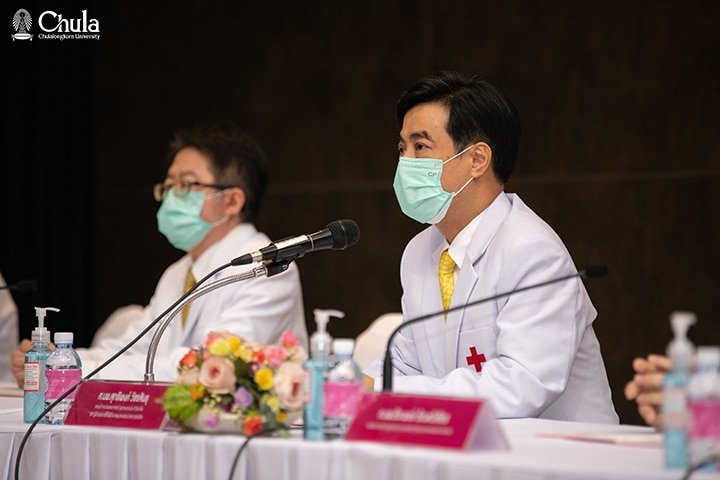 Prof. Dr. Suttipong Wacharasindhu Prof. Dr. Suttipong Wacharasindhu, Dean of CU Medi and Director of Chulalongkorn Hospital said that both CU Medi and Chulalongkorn Hospital have been developing the services, healthcare innovation, medical equipment, and application of modern technology to patient care to ready themselves for the current and future changes in the field of medicine. They have an extensive body of research and medical innovations on stem cells. Most recently, the Rheumatology Division, in collaboration with Hematology, Pulmonary and Critical Care Medicine, and Infectious Diseases Departments were the first in Thailand to successfully treat two systemic sclerosis patients with pulmonary fibrosis by stem-cell transplantation. Such success demonstrates the expertise, specialization, and dedication of the healthcare teams in applying knowledge, research and medical technology on stem cells to help improve patients' quality of life. 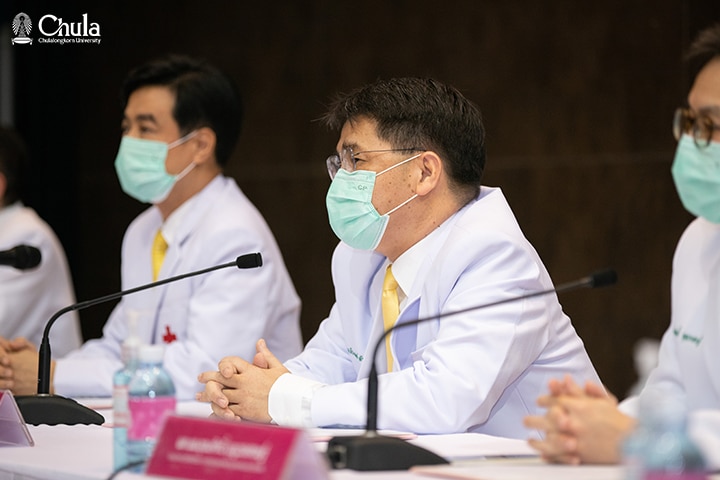 Prof. Dr. Thiraphong Tanthawichien Prof. Dr. Thiraphong Tanthawichien, Head of the Department of Medicine, CU Medi said that the success in treating systemic sclerosis patients with pulmonary fibrosis by stem cell transplantation is a source of great pride for CU Medi. It is a modern treatment that is made possible because of the cooperation from specialists in various fields and will be optimized to benefit the whole country in the future. 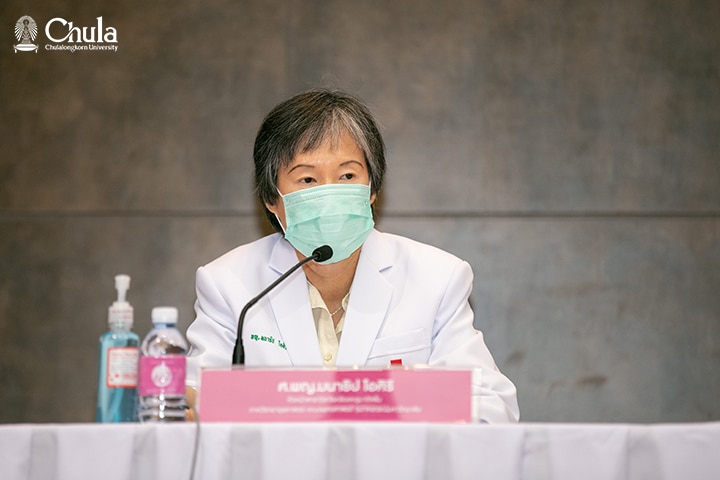 Prof. Dr. Manathip Osiri Prof. Dr. Manathip Osiri, Head of Rheumatology, Department of Medicine, CU Medi said that systemic sclerosis is an autoimmune disease that can cause malfunctions of many internal organs. It is characterized by the formation of fibrosis on the skin and internal organs. It hardens the skin and causes fibrosis in the lungs, and cardiac muscles, and can lead to an enlarged heart and heart failure. It also causes fibrosis of the smooth muscles in the digestive tract and rendered the compression of the esophagus, stomach, small intestine, and colon ineffective or impossible. Such symptoms, when coupled with the narrowing of the arteries can limit blood supply to the fingers, and cause pulmonary hypertension, which may lead to a heart attack. Most patients suffer chronic symptoms, while some can suffer acute onsets and die. Systemic sclerosis is not common, with about 4-35 cases per 100,000 population, and 3 times more common in females than males. The average age of people when onset occurs is 40-50 years old. Cases are found mostly in the North and the Northeast of Thailand. The causes of death for patients are usually pulmonary fibrosis, pulmonary hypertension, and heart attacks. Treatment should be started early after diagnosis to delay the progression of the disease and relieve sufferings for the patients. Medications to treat this disease and control its progression include vasodilator drugs, immunosuppressants, used in combination with drugs that help slow down or reduce the fibrosis. However, these drugs are only effective in patients with gradual symptoms. In patients with acute and aggressive progression, treatment by regenerating the immune system to regulate its function will help slow down the disease progression, reduce damage to the organs, and prevent premature death. Asst. Prof. Dr. Udomsak Bunworasate, Head of Hematology, CU Medi revealed that the way to effectively treat this type of autoimmune disease that causes inflammation and fibrosis in the organs is aiming to eliminate the malfunctioning immune cells and normalize the immune system. Such treatment is usually not possible with a regular dose of immunosuppressants but should be done with a high dose together with antibody treatment, followed by stem-cell transplantation created from the patients' stem cells harvested during the treatment. The hematopoietic stem-cell transplantation will help patients recover faster, and regenerate new immune cells. In other words, this is a rearrangement of the immune system by stem-cell transplantation. The first step is to select the right patients for the treatment. The next step is to harvest the stem cells and freeze them. During this period, the patients are kept in a sterilized room and cared for by a team of doctors and nurses specializing in caring for people with low immunity. After the stem cells start to work, patients will have their immune systems restored to normal and can be discharged from the hospital. They will then be periodically monitored, to see the progress of stem-cell transplantation. 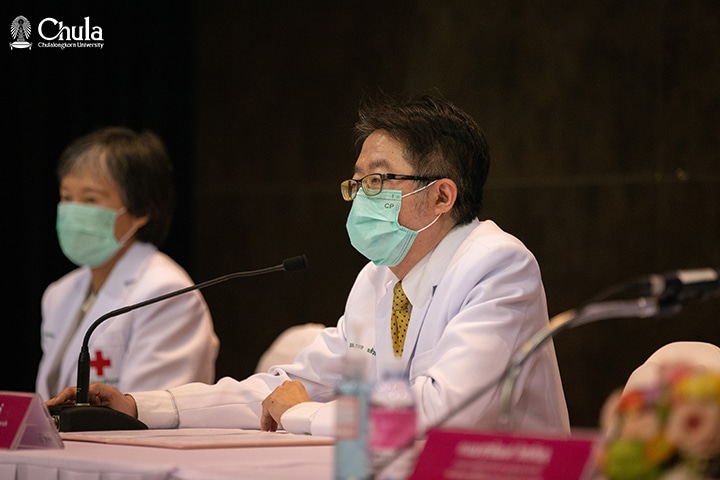 Assoc. Prof. Dr. Kamon Kaewkitinarong Assoc. Prof. Dr. Kamon Kaewkitinarong, Head of the Pulmonary and Critical Care Medicine, CU Medi, observed that most systemic sclerosis patients with pulmonary fibrosis also suffer from noninfectious inflammation. Patients often show symptoms of dry coughs and shallow breaths which induce hyperventilation. They are easily fatigued after exertion and become less active. Disease progression differs for each patient and is unpredictable. The fibrosis may occur and stop, or keep spreading aggressively; the latter of which is found in patients with recent onsets. Some patients may also experience pulmonary hypertension, which may then cause a right ventricular cardiac arrest. During the disease progression, the pulmonary inflammation caused by the fibrosis may get worse, or trigger more complications. These conditions will further deteriorate the lungs and drastically deplete blood oxygen. Those with critically low oxygen will need a ventilator and have a high risk of losing their lives. After a thorough physical examination, doubtful cases will receive additional pulmonary CT scans that will greatly help with the diagnosis of pulmonary fibrosis. When pulmonary fibrosis is found, follow-up is very important. Periodic examinations and CT scans are done every six months, or possibly sooner if the patients' condition worsens. 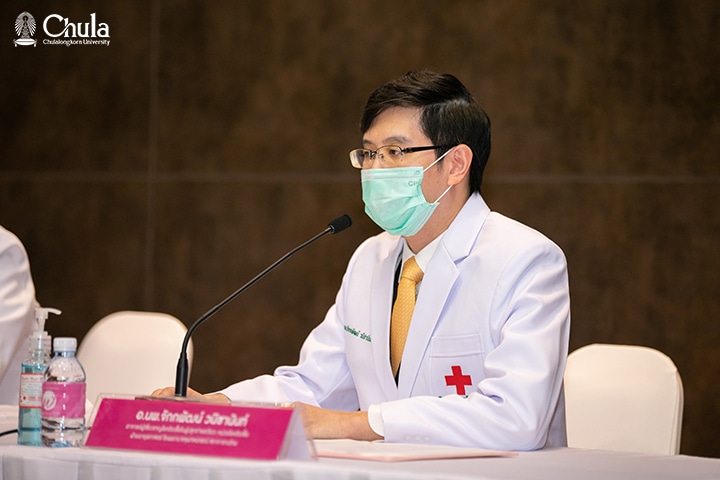 Dr. Chakkapat Vanichanan Dr. Chakkapat Vanichanan, Lecturer and Transplant Infectious Disease Specialist, Department of Medicine, Chulalongkorn Hospital, concluded that preparing the patients by assessing the risk of infection and screening for latent infection before stem-cell transplantation, as well as prescribing antibacterial drugs are very important preventive steps to reduce the likelihood of infections. The top concern for systemic sclerosis patients with pulmonary abnormality who are candidates for stem-cell transplantation is pneumonitis which may be caused by bacteria, especially drug-resistant bacteria, or fungal infection. This will worsen the already-troubled respiratory system and can cause early respiratory failure and deterioration of the lungs in the long run. Therefore, intensive monitoring after stem-cell transplantation plus immediate prescription of antibacterial drugs once there is a sign of infection will reduce the death rate in the patients.  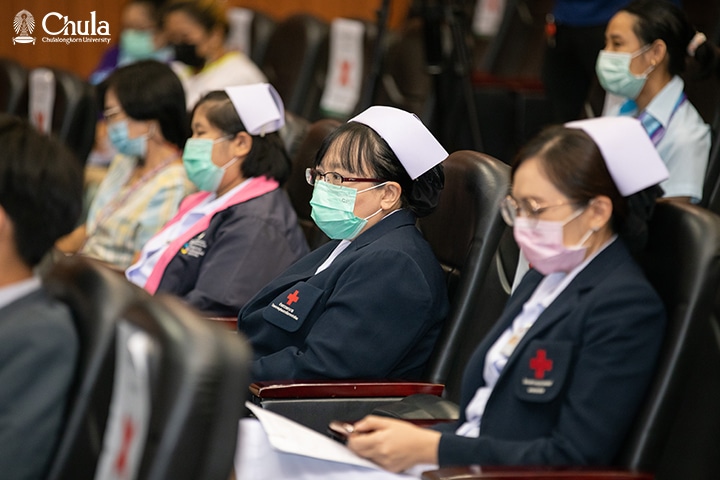 |
| You are subscribed to email updates from "pulmonary hypertension medications" - Google News. To stop receiving these emails, you may unsubscribe now. | Email delivery powered by Google |
| Google, 1600 Amphitheatre Parkway, Mountain View, CA 94043, United States | |
Comments
Post a Comment